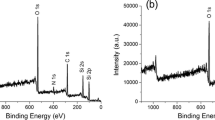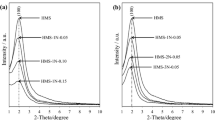Abstract
Mesoporous organic–inorganic hybrid silica with ethylidene bridging group between two silicon atoms was prepared via a sol–gel and hydrothermal synthesis process by using silsesquioxane (1,2-bis(triethoxysilyl) ethane, BTESE) as silicon source and triblock copolymer poly(ethylene glycol)-b-poly(propylene glycol)-b-poly(ethylene glycol) (P123) in combination with dodecyltrimethylammonium bromide (DTAB) as template. Factors that affect the morphology and pore structure of silica particles were investigated in detail by means of scanning electron microscopy, transmission electron microscopy and nitrogen adsorption–desorption. The results show that the sphericity and surface smoothness of organic–inorganic hybrid silica are distinctly enhanced with increasing amount of DTAB and hydrochloric acid. Meanwhile, suitable synthesis time and crystallization temperature are beneficial to the formation of silica spheres with improved sphericity. The organic–inorganic hybrid silica spheres prepared with a DTAB/BTESE molar ratio of 0.8, a HCl/BTESE molar ratio of 6, an aging time of 24 h and a crystallization temperature of 100 °C exhibit a particle size of around 1.7 µm, a high surface area of 1063.35 m2 g−1 and a narrow pore size distribution centered at 3.12 nm.
Graphical Abstract











Similar content being viewed by others
References
Fiorilli S, Tallia F, Pontiroli L, Vitale-Brovarone C, Onida B (2013) Spay-dried mesoporous silica spheres functionalized with carboxylic groups. Mater Lett 108:118–121
Mandal M, Manchanda AS, Zhuang JQ, Kruk M (2012) Face-centered-cubic large-pore periodic mesoporous organosilicas with unsaturated and aromatic bridging groups. Langmuir 28:8737–8745
Ying JY, Mehnert CP, Wong MS (1999) Synthesis and applications of supramolecular-templated mesoporous materials. Angew Chem Int Ed 38:56–77
Stein A, Melde BJ, Schroden RC (2000) Hybrid inorganic–organic mesoporous silicates—nanoscopic reactors coming of age. Adv Mater 12:1403–1419
Sayari A, Hamoudi S (2001) Periodic mesoporous silica-based organic–inorganic nanocomposite materials. Chem Mater 13:3151–3168
Lin HP, Mou CY (2002) Structural and morphological control of cationic surfactant-templated mesoporous silica. Acc Chem Res 35:927–935
Stöber W, Fink A (1968) Controlled growth of monodisperse silica spheres in the micron size range. J Colloid Interface Sci 26:62–69
Schüth F, Schmidt W, Zibrowius B, Galeano C (2014) Highly microporous monodisperse silica spheres synthesized by the Stöber process. Microporous Mesoporous Mater 200:317–325
Wang ZS, Chen LY, Li MF, Cheng XB, Sang T, Shen ZX, Wang XD (2010) Preparation of spherical silica particles by Stöber process with high concentration of tetra-ethyl-orthosilicate. J Colloid Interface Sci 341:23–29
Zhao XJ, Cheng B, Yu JG, Zhao L (2003) Preparation and formation mechanisms of monodispersed silicon dioxide spherical particles. Acta Chim Sin 61:562–566
Van Der Voort P, Sandra P, Lynen F, Van Driessche I, Wallaert E, Ide M (2011) Spherical mesoporous silica particles by spray drying: doubling the retention factor of HPLC columns. Microporous Mesoporous Mater 142:282–291
Muylaert I, Van Der Voort P (2009) Supported vanadium oxide in heterogeneous catalysis: elucidating the structure-activity relationship with spectroscopy. Phys Chem Chem Phys 11:2826–2832
Hudson MJ, Knowles JP, Harris PJF, Jackson DB, Chinn MJ, Ward JL (2004) The trapping and decomposition of toxic gases such as hydrogen cyanide using modified mesoporous silicates. Microporous Mesoporous Mater 75:121–128
De Canck E, Lapeire L, De Clercq J, Verpoort F, Van Der Voort P (2010) New ultrastable mesoporous adsorbent for the removal of mercury ions. Langmuir 26:10076–10083
Van Der Voort P, Vercaemst C, Schaubroeck D, Verpoort F (2008) Ordered mesoporous materials at the beginning of the third millennium: new strategies to create hybrid and non-siliceous variants. Phys Chem Chem Phys 10:347–360
Zhao DY, Sun JY, Li QZ, Stucky GD (2000) Morphological control of highly ordered mesoporous silica SBA-15. Chem Mater 12:275–279
Zhao JW, Gao F, Fu YL, Jin W, Yang PD, Zhao DY (2002) Biomolecule separation using large pore mesoporous SBA-15 as a substrate in high performance liquid chromatography. Chem Commun 7:752–753
Feng G, Zhao JW, Zhang S, Zhou F, Jin W, Zhang XM, Yang PY, Zhao DY (2002) Application of C18-modified mseoporous SBA-15 as the substrate for high performance liquid chromatography. Chem J Chin Univ 23:1494–1497
Stucky GD, Chmelka BF, Zhao DY, Yang PD (1998) Triblock-copolymer-directed syntheses of large-pore mesoporous silica fibers. Chem Mater 10:2033–2036
Xia YD, Mokaya R (2005) High surface area ethylene-bridged mesoporous and supermicroporous organosilica spheres. Microporous Mesoporous Mater 86:231–242
Mokaya R, Xia YD, Yang ZX (2006) Molecularly ordered ethylene-bridged periodic mesoporous organosilica spheres with tunable micrometer sizes. Chem Mater 18:1141–1148
Mokaya R, Xia Y (2006) Surfactant mediated control of pore size and morphology for molecularly ordered ethylene-bridged periodic mesoporous organosilica. J Phys Chem B 110:3889–3894
Lu GQ, Yu CZ, Wang LZ, Qiao SZ, Zhou XF, Dioioputro H (2006) Periodic mesoporous organosilica hollow spheres with tunable wall thickness. J Am Chem Soc 128:6320–6321
Allen T (1980) Particle size measurement, 4th edn. Chapman and Hall, London
Hanrahan JP, Donovan A, Morris MA, Holmes JD (2007) Synthesis and swelling of large pore diameter mesoporous silica spheres. J Mater Chem A 17:3881–3887
Ma Y, Qi LM, Ma JM, Wu YQ, Liu Q, Cheng HM (2003) Large-pore mesoporous silica spheres: synthesis and application in HPLC. Colloids Surf A Physicochem Eng Asp 229:1–8
Wang L, Qi T, Zhang Y, Chu JL (2006) Morphosynthesis route to large-pore SBA-15 microspheres. Microporous Mesoporous Mater 91:156–160
Shi EW (2004) Hydrothermal crystallography, 8th edn. Science Press, Beijing
Zhao DY, Huo QS, Feng JL, Chmelka BF, Galen D (1998) Nonionic triblock and star diblock copolymer and oligomeric surfactant syntheses of highly ordered, hydrothermally stable, mesoporous silica structures. J Am Chem Soc 120:6024–6036
Lin CY, Qiu Y, Jiang LQ (2000) Micellar structure of pluronic F127 and P123 triblock copolymers. J Fuzhou Univ (Nat Sci) 28:77–81
Huo Q, Margolese DL, Ciesla U, Feng PY, Gier TE, Sieger P, Leon R, Petroff PM, Schüth F, Stucky GD (1994) Generalized synthesis of periodic surfactant/inorganic composite materials. Nature 368:317–321
Huo Q, Margolese DL, Ciesla U, Feng PY, Gier TE, Sieger P, Leon R, Petroff PM, Schüth F, Stucky GD (1994) Organization of organic molecules with inorganic molecular species into nanocomposite biphase arrays. Chem Mater 6:1176–1191
Zhou LH, Zhang LZ, Liu HL (2006) Effect of crystallization temperature on structure and morphology of mesoporous SBA-15. Chin J Process Eng 6:499–502
Wang HJ, Guo YP, Lang WZ, Guo YJ (2009) Effect of different crystallization temperature on the crystalline structure and morphology of zeolite ZSM-5. GuangZhou Chem Ind 37:89–92
Acknowledgments
This research is financially supported by National Natural Science Foundation of China (Grant Nos. 21171014, 50502002 and 51402007), Scientific Research Common Program of the Beijing Municipal Commission of Education (Grant Nos. KZ201410005006 and KM201210005012), State Key Laboratory of Solid Waste Reuse for Building Materials (Grant No. SWR-2014-010), Beijing Natural Science Foundation of China (Grant No. 2141001) and Funding Project for Academic Human Resources Development in Institutions of Higher Learning Under the Jurisdiction of Beijing Municipality.
Author information
Authors and Affiliations
Corresponding authors
Rights and permissions
About this article
Cite this article
Jiang, DD., Wei, Q., Cui, SP. et al. Controllable morphology and pore structure of micron-sized organic–inorganic hybrid silica spheres derived from silsesquioxane. J Sol-Gel Sci Technol 78, 40–49 (2016). https://doi.org/10.1007/s10971-015-3926-7
Received:
Accepted:
Published:
Issue Date:
DOI: https://doi.org/10.1007/s10971-015-3926-7




